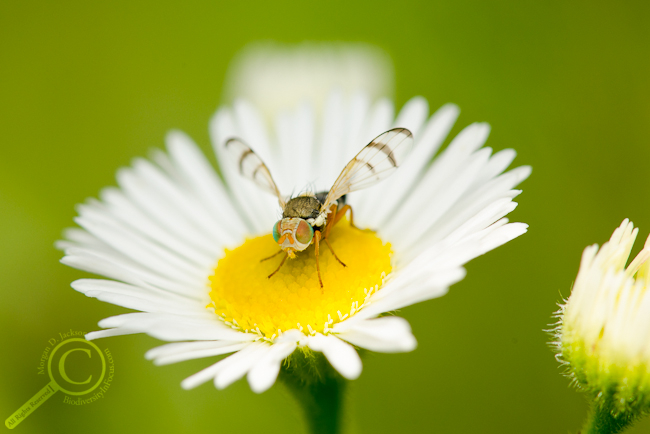Urophora affinis, a fruit fly in the family Tephritidae, was introduced to Ontario in the 1970’s as a biological control agent for invasive European knapweeds. When the researchers went back to check on the population a few years later, they were unable to find the species again, and concluded that the population failed to become established (at least in Ontario, a similar introduction in British Columbia did survive).
Fast forward to 2008 when Adam Brunke (a beetle specialist, ironically) collected a specimen in his parent’s backyard, nearly 200 kilometers away from the original introduction site! Clearly Urophora affinis had not only survived, but had even managed to expand it’s range across a large portion of central Ontario, a story which I reported in my paper on Ontario Tephritidae last spring.
Later on in the summer, I accompanied Adam and Steve Paiero (of tongue parasite fame) out to Northumberland County (much closer to the original introduction site) where they were conducting a survey, and happened to find a thriving population of Urophoa affinis in a nice sunny clearing. Nearly every composite flower had an individual or two on top feeding and/or mating, and we collected a long series to place in the University of Guelph Insect Collection. I also walked away with a number of nice photos documenting the species in a new location.
It just goes to show that a species can find a way to survive and prosper, even if they go unnoticed by us!


Have you seen any biocontrol impacts in those areas?
I really don’t have any data to answer that since we are only now realizing the fly is still present. It would definitely be an interesting project to discover whether there has been any decrease in knapweed growth, but at this point we only have 2 confirmed localities where the fly has been found. Something to watch for in the future, and perhaps an interesting problem for an undergraduate summer project down the road!
Alas, I grubbed out all my ornamental knapweeds last year after one made it on to the new weed list, so I probably won’t get to see the attractive fly in the Home Bug Garden (the weedy ones out here seem to be rangeland pests down south). The knapweeds did tend to recruit with a bit too much abandon, but the bees liked them. As a seed predator, though, any impact on knapweed by U. affinis would probably not be very obvious. My understanding is that it was not thought very effective on its own.
No, from what I understand it didn’t work out quite as well as the research team may have hoped. Still a nice fly to look at though, and probably not having much of an impact on any native species (other than a little nectar competition perhaps).
That is a stunning photograph! Its interesting that they expanded their range so wide without being noticed for so long!
Thanks Ani! It is pretty odd that it escaped notice for so long, especially as it moved through some of the most popular vacation regions in Ontario and near some major population centres.